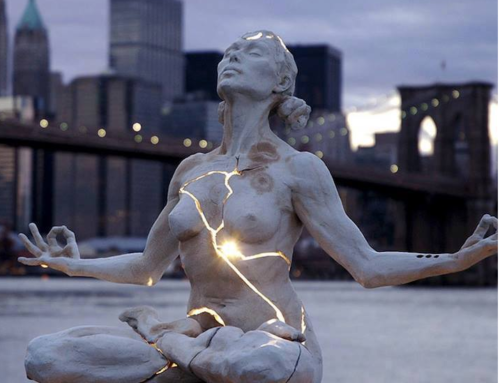I just want to be myself.
Ever think or say this to yourself? I found myself saying this to myself a lot. I wanted to be the ‘I’ I was before she got limited by conditions. The ‘I’ that knew about how to have a more complete experience. My daughter understood something related to this when she was only about 4 years old. She would plead ‘come beee with me!’ when she wanted my full and complete attention.
We seem to know that being ourselves and being with others who are being themselves is fundamental to our overall wellbeing. But how does something like simply being become impossible to do? And once again, what does this have to do with crying…we’ll get to that soon.
Being is something that happens naturally, moment to moment, as a flow of activity, a flow of experiencing or knowing. We don’t make experiencing, or knowing or being happen, they arise in awareness spontaneously.
This flow-of-being activity in awareness is continuously moving and changing, experiencing and knowing in different ways and expressed as body/emotion/mind/spirit. And we know when we look at blood or air or saliva or food digestion, things need to keep flowing and changing in body/emotions/mind/spirit or problems happen. Flow allows information to spread, be completely known and expressed as human being.
- Body flows as the experience and expression of physical vibrations and restful sensations
- Emotion flows as the experience and expression of feelings
- Mind flows as the experience and expression of concepts in words or pictures
- Spirit flows as the experience and expression of knowingly being loving
So, for example, the body can know physical and/or emotional information without words. It relies on vibration, shaking, expanding/contracting, subtle or gross pressures, non-word sounds, crying, etc. to know what is happening and what is needed. We also rely on visual and auditory perceptions that may not have words. When these non-verbal movements are blocked or we distract from them with substances, constant activity, relationships, etc. then information in the flow of experience is not available to awareness.
A traffic light is a good example. We see the red and we stop, we see the green we go. No words needed, the information flows and the body knows what to do. But if we are distracted with conversation or fiddling with the radio or texting then the information is present but cannot flow because attention is elsewhere. With distraction it is easy to run a red light or sit at a green one until prompted by a honk from behind. The moment we know the light is green we naturally start moving.
Allowing flow on all levels of our being is a lifelong process and crying can support the flow of information on all levels of the process.
As we saw in part 2 a lot of habits and conditioning over a lifetime can interrupt what we attend to and block the flow of experience in awareness. In my case quiet drip-crying for decades stopped the flow of information and prevented a complete experience.
I told myself I was experiencing things, knowing things because I seemed to be crying a lot, but I misunderstood. When I really cried and shook and expanded and then contracted into calm, with focused attention without interference, the experience was complete and the next action took itself. I moved on from a 27-year relationship. It really can be that simple. My attention was not distracted by habit anymore, I truly knew it was time to go, the light was green and movement happened.
So here are 4 tips for crying effectively in general, not just when big events break us open.
Self-Compassion
- Offer yourself compassion right now, no matter who you are or how you cry or don’t cry. In our culture we get so conditioned by shame or fear to do and not do things—don’t cry, do be competitive, don’t be vulnerable, do make money, don’t be afraid, do at least look perfect, don’t be a wimp, etc. Self-compassion is an all-purpose good thing to do for yourself. Self-compassion helps us heal shame and let go of fear. Then we can make choices from all emotions—kindness, curiosity, passion, practicality—rather than choices pushed by attention to only shame or fear.
Do it Now
- Don’t postpone a cry when it wants to happen. It has information that is important to your whole system—body, mind, emotions, spirit. Even the smaller non-sobbing cryings are important. You’ll be surprised how quickly you will feel refreshed and ready to move back into your day.
Let the whole body be involved when it wants to
- Allow full body sobbing when it wants to happen. Sometimes a few tears is all that is needed in terms of flow. But if sobbing presents itself, let ‘er rip! It may only be for 1minute but a subtle shift happens (remember, subtle is significant) and the difference of completion will be sensed on many levels when you allow the full flow of experience.
Ignore the mind’s demands for answers
- Sometimes we know exactly why we are crying. But if we don’t, the mind usually wants to ‘understand why’ you are crying. You might interrupt the flow if you start thinking about ‘what’s wrong?, why am I crying?, I have no reason to be crying, real men don’t cry’. In fact, sometimes the mind gets active just for the purpose of distracting you from something it cannot understand. Sometimes the mind never understands why you are crying, but trust that the emotion and spirit aspects of your system can still know the information and make use of it in their own way.
If none of this makes any sense to you, don’t do it
- Just doing a lot of crying because ‘someone told me to’ may produce feeling worse, not better and cause even more blockage. Wait until you actually are a little curious about experimenting with something foreign and at least a little uncomfortable. Or maybe talk to someone first about it and get some support. Crying alone is very different from crying with someone.
Have a good cry. Crying is not the answer but it might carry information about an experience that is the answer. Most of all, let things flow. Be yourself!










Leave A Comment